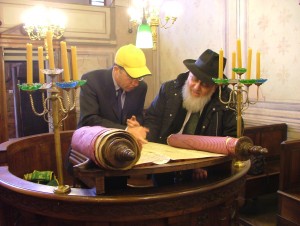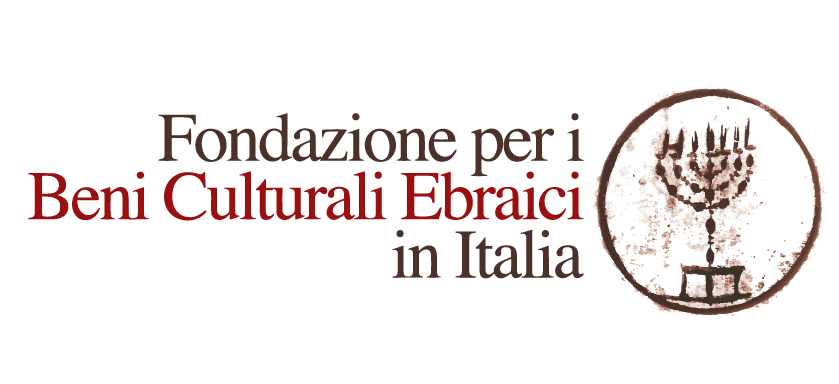The Board meeting of the Foundation for Jewish Cultural Heritage in Italy, which was held in Rome today, opened with “exciting news of extraordinary importance to Italian Judaism”. With this introduction president Dario Disegni announced the results of a scientific analysis carried out by the University of Illinois on a Sefer Torah of the synagogue of Biella, written in Ashkenazi script, recently restored by sofer Amedeo Spagnoletto on behalf of the Foundation. Carbon 14 tests, in fact, date the scroll at 1250, ranking it as the world’s oldest of European origin in the possession of a Jewish community and suitable for reading. This weekend the sefer will return to Biella, where a solemn ceremony will welcome it back to the synagogue.
The restoration of the valuable sefer, preserved by the Jewish Community of Vercelli to which Biella belongs, is an initiative undertaken by the current Board of the Foundation for Jewish Cultural Heritage in Italy as part of its work to promote the recovery, preservation, restoration and promotion of Italian Jewish historical and artistic heritage. “It is not uncommon to come across very old Sefer Torah”, explains Spagnoletto, who is responsible for its discovery, in his presentation of the Carbon test results to the FBCEI Council, “but in this case the scroll was still completely intact, without a single parchment having been replaced from 1250 up to today”. Due to its extraordinary condition, emphasised the sofer, the restoration of the scroll was particularly delicate, and involved cleaning the parchments, filling in the letters with partially erased or cracked ink, and restoring all the woodworm holes with parchment paste and filling in the relative broken letters. The problem, explained Spagnoletto, was that in working on the medieval style there was a risk of altering the original sefer’s structure and making it non-kosher, i.e. unsuitable for reading. This characteristic, in fact, further increases its value. “We are talking about the oldest sefer still fulfilling its original purpose”, Spagnoletto says, “as opposed to others that have been discovered which today are displayed in museums or kept in libraries and institutions not belonging to the Jewish communities”.
The manuscript comes from the “cradle of Europe, from an area that extends from Northern Italy to the Rhine Valley,” adds the sofer. For this reason “today marks the beginning of an initiative that involves not only restoration but also analysis” geared to determining the history that brought the sefer to the synagogue of Biella. It is also particularly significant, president Disegni pointed out, that the oldest and most valuable cultural legacy was discovered “in the smallest part of the smallest Italian Jewish Community, proving that very important contributions can also come from very small contexts.”
Emphasis was placed, therefore, on the need to find new resources for funding this important restoration. Considering the high value of the sefer, Disegni said, “this is a small project with a modest budget, reflecting a precise policy of the Board of the Foundation”. To support the project, for the first time in the cultural world of Italian Judaism a crowdfunding campaign has also recently been launched, making it possible to receive donations that are “smaller but, at the same time, come from a wider range of sources.” With the current difficulties in obtaining public funding, Disegni pointed out, all the country’s cultural entities are looking for alternative ways to mobilize funds for projects and initiatives, and crowdfunding has become one of the most popular due to the positive results it has so far achieved. “We believe it will be useful to apply it also in the context of Italian Judaism”, he said, “with a campaign targeted to everyone.”
important restoration. Considering the high value of the sefer, Disegni said, “this is a small project with a modest budget, reflecting a precise policy of the Board of the Foundation”. To support the project, for the first time in the cultural world of Italian Judaism a crowdfunding campaign has also recently been launched, making it possible to receive donations that are “smaller but, at the same time, come from a wider range of sources.” With the current difficulties in obtaining public funding, Disegni pointed out, all the country’s cultural entities are looking for alternative ways to mobilize funds for projects and initiatives, and crowdfunding has become one of the most popular due to the positive results it has so far achieved. “We believe it will be useful to apply it also in the context of Italian Judaism”, he said, “with a campaign targeted to everyone.”
There were other items on the agenda of the meeting, reflecting the Foundation’s many fields of activity. Some of the projects currently underway are the cataloguing of Jewish cultural heritage, for which an agreement has been reached with the Central Institute for Cataloguing and Documentation, a major exhibition marking the 50th Anniversary of the flood of the River Arno in Florence, for which some of the damaged books will be restored and displayed, participation in events for the 5th centenary of the Ghetto of Venice, and the publishing of the website and Internet portal dedicated to tourist hotspots and itineraries. The FBCEI Council concluded the meeting by approving the final budget of 2015.
The restoration of the valuable sefer, preserved by the Jewish Community of Vercelli to which Biella belongs, is an initiative undertaken by the current Board of the Foundation for Jewish Cultural Heritage in Italy as part of its work to promote the recovery, preservation, restoration and promotion of Italian Jewish historical and artistic heritage. “It is not uncommon to come across very old Sefer Torah”, explains Spagnoletto, who is responsible for its discovery, in his presentation of the Carbon test results to the FBCEI Council, “but in this case the scroll was still completely intact, without a single parchment having been replaced from 1250 up to today”. Due to its extraordinary condition, emphasised the sofer, the restoration of the scroll was particularly delicate, and involved cleaning the parchments, filling in the letters with partially erased or cracked ink, and restoring all the woodworm holes with parchment paste and filling in the relative broken letters. The problem, explained Spagnoletto, was that in working on the medieval style there was a risk of altering the original sefer’s structure and making it non-kosher, i.e. unsuitable for reading. This characteristic, in fact, further increases its value. “We are talking about the oldest sefer still fulfilling its original purpose”, Spagnoletto says, “as opposed to others that have been discovered which today are displayed in museums or kept in libraries and institutions not belonging to the Jewish communities”.
The manuscript comes from the “cradle of Europe, from an area that extends from Northern Italy to the Rhine Valley,” adds the sofer. For this reason “today marks the beginning of an initiative that involves not only restoration but also analysis” geared to determining the history that brought the sefer to the synagogue of Biella. It is also particularly significant, president Disegni pointed out, that the oldest and most valuable cultural legacy was discovered “in the smallest part of the smallest Italian Jewish Community, proving that very important contributions can also come from very small contexts.”
Emphasis was placed, therefore, on the need to find new resources for funding this
 important restoration. Considering the high value of the sefer, Disegni said, “this is a small project with a modest budget, reflecting a precise policy of the Board of the Foundation”. To support the project, for the first time in the cultural world of Italian Judaism a crowdfunding campaign has also recently been launched, making it possible to receive donations that are “smaller but, at the same time, come from a wider range of sources.” With the current difficulties in obtaining public funding, Disegni pointed out, all the country’s cultural entities are looking for alternative ways to mobilize funds for projects and initiatives, and crowdfunding has become one of the most popular due to the positive results it has so far achieved. “We believe it will be useful to apply it also in the context of Italian Judaism”, he said, “with a campaign targeted to everyone.”
important restoration. Considering the high value of the sefer, Disegni said, “this is a small project with a modest budget, reflecting a precise policy of the Board of the Foundation”. To support the project, for the first time in the cultural world of Italian Judaism a crowdfunding campaign has also recently been launched, making it possible to receive donations that are “smaller but, at the same time, come from a wider range of sources.” With the current difficulties in obtaining public funding, Disegni pointed out, all the country’s cultural entities are looking for alternative ways to mobilize funds for projects and initiatives, and crowdfunding has become one of the most popular due to the positive results it has so far achieved. “We believe it will be useful to apply it also in the context of Italian Judaism”, he said, “with a campaign targeted to everyone.”There were other items on the agenda of the meeting, reflecting the Foundation’s many fields of activity. Some of the projects currently underway are the cataloguing of Jewish cultural heritage, for which an agreement has been reached with the Central Institute for Cataloguing and Documentation, a major exhibition marking the 50th Anniversary of the flood of the River Arno in Florence, for which some of the damaged books will be restored and displayed, participation in events for the 5th centenary of the Ghetto of Venice, and the publishing of the website and Internet portal dedicated to tourist hotspots and itineraries. The FBCEI Council concluded the meeting by approving the final budget of 2015.
Recent Posts




